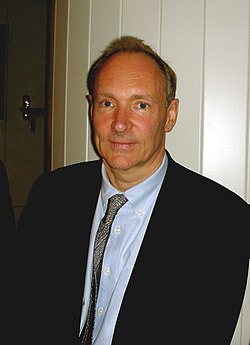|
Vikidia currently has 4,625 articles. Improve it! |
|
Join Vikidia: create your account now and improve it! |
Tim Berners-Lee
Sir Timothy John Berners-Lee [1] (born 8 June 1955),[2] is a British computer scientist who is best known as the inventor of the World Wide Web. In 1989, Berners-Lee, a graduate of Oxford University, made a proposal for an information sharing system while working at CERN, the European Particle Physics Laboratory.[3] His proposal was not accepted as a project for CERN. However, he was given time to work on the project on his own.[4] In 1990 he wrote the first web page and others were invited to join in and create web pages using his software.[4]
Life[edit | edit source]
He was born on June 8, 1955 in London, England.[5] He attended Emanuel School, then went to Queen’s College, Oxford University.[5] There he received a degree in physics.[5] After graduating Berners-Lee worked for Plessey Telecommunications[2] in Poole, England.[5] In 1978 he worked for D.G Nash, Ltd., as a software engineer. In 1980 he joined CERN in Switzerland as a consulting software engineer.[2] In 1984 he wrote a paper "Information Management: A Proposal".[6] He described the concept of hypertext used on an internetwork (internet) to share information within a company and also globally.[6] He called it the World Wide Web.[6] The idea was not an immediate success. With the help of CERN computer scientist Robert Cailliau and others he continued to develop the idea.[6] By 1990 the first web page had been written. Others were invited to participate and create web pages.[4] As the web grew, Berners-Lee decided everyone should be able to participate and without paying any fees.[4]
Berners-Lee's contributions to the World Wide Web did not make him rich, like Microsoft founder Bill Gates.[7] To make sure the web remained accessible without royalties or fees, in 1994 he formed the World Wide Web Consortium.[7] The Consortium promotes standards and protocols and helps to work out problems between companies who develop web based services and products.[7]
Positions and honors[edit | edit source]
Berners-Lee is the Director of the World Wide Web Consortium (W3C), the Web standards organization founded in 1994.[8] He is a founder and Director of the Web Science Trust (WST) started in 2009.[8] He is also a Director of the World Wide Web Foundation which was also launched in 2009.[8] He is a professor of Engineering at MIT. He is also a professor of Electronics and Computer Science at the University of Southampton, UK.[8]
He became a Fellow of the Royal Society in 2001.[8] In 2004 he was Knighted by Queen Elizabeth II of the United Kingdom.[8] He was awarded the Order of Merit in 2007.[8]
 |
This does not have many mainspace categories. You can help by adding more categories. |
||
|
References[edit | edit source]
- ↑ http://news.bbc.co.uk/1/hi/technology/3357073.stm
- ↑ 2.0 2.1 2.2 The International Who's Who 2004, 67th Edition (London; New York: Europa Publications, 2003), p. 153
- ↑ "Tim Berners-Lee". The World Wide Web Consortium (W3C). https://www.w3.org/People/Berners-Lee/. Retrieved 8 July 2016.
- ↑ 4.0 4.1 4.2 4.3 "History of the Web". World Wide Web Foundation. http://webfoundation.org/about/vision/history-of-the-web/. Retrieved 8 July 2016.
- ↑ 5.0 5.1 5.2 5.3 "Tim Berners-Lee Biography". Biography Online. http://www.biographyonline.net/business/tim-berners-lee.html. Retrieved 8 July 2016.
- ↑ 6.0 6.1 6.2 6.3 "Tim Berners Lee (1955 - )". History. BBC. http://www.bbc.co.uk/history/historic_figures/berners_lee_tim.shtml. Retrieved 8 July 2016.
- ↑ 7.0 7.1 7.2 "Tim Berners-Lee". NNDB. http://www.nndb.com/people/573/000023504/. Retrieved 8 July 2016.
- ↑ 8.0 8.1 8.2 8.3 8.4 8.5 8.6 "Tim Berners-Lee". Internet Hall of Fame. The Internet Society. http://internethalloffame.org/inductees/tim-berners-lee. Retrieved 8 July 2016.
